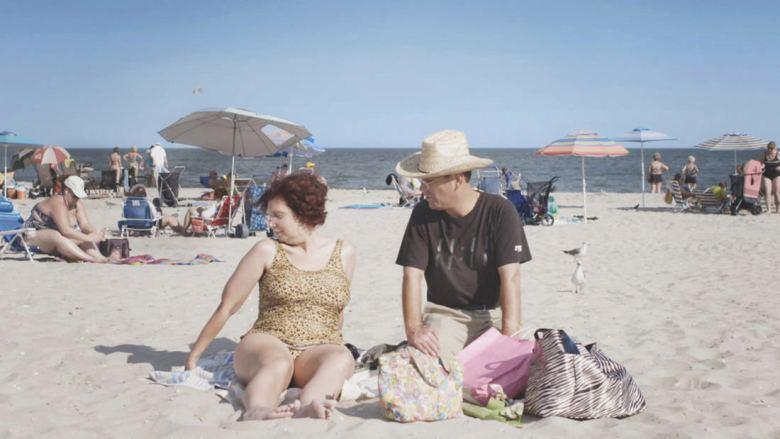_Dina_ follows a woman close to 50-years-old who is getting married for the second time. Dina and Scott both have mental disabilities (Scott has Asperger’s, while Dina’s issues are “like a smorgasbord,” according to her mother).
The documentary feels like a real-life rom-com, especially in the beginning. Soft, humming music plays as the audience is introduced to Dina and her friends, family and quirks. Throughout the movie, it’s easy to forget that it’s a documentary because of the way it’s shot. Wide shots capture the setting and the camera nearly never shakes the way you think it would in a non-fiction film.
We follow their relationship as they head towards marriage and how it’s both different and similar to what is thought of as a “conventional” romance. Dina and Scott hold hands on the bus and have dinner together, but they also talk about the troubles they face, both personally and in their relationship as a result of their mental disabilities. Dina is often frustrated with Scott’s lack of sexual interest, though you can’t deny his devotion to her. At one point, she gives him a book about sex, to try to spark his interest. Nothing really works, but Scott continually promises that he’ll try to do better for her in that area.
The movie follows very human situations — which should be obvious because it’s a true documentary — and it’s very refreshing to watch. Dina and Scott go to Ocean City, New Jersey, where Scott sees the ocean for the first time and quells Dina’s swimsuit insecurities. Dina has a bachelorette party where a male stripper makes an appearance. The couple has dinner with friends and we see the guys and girls chatting in different rooms afterwards.
Prior to their wedding, there is a scene whose composition felt very similar to that of a fictional rom-com. Dina makes a trip to an “adult store” while Scott goes to pick up his tux, and the film switches between the scenes while soft, romantic music plays. It feels like that point in a rom-com when you know that everything will turn out alright and that everyone will be happy in the end. However, we can’t rely on those notions because this is a documentary about real, unpredictable people. We want it to end happily, but anything can happen.
The wedding scene was simple and casual. Someone showed up in an Eagles jersey. Lots of footage of family tensions had to be cut from this scene, directors Antonio Santini and Dan Sickles said during the Q&A. They just wanted to focus on Dina and Scott’s marriage and happiness. We even follow the couple to their honeymoon, which involves a champagne glass-shaped bathtub. The film is intimate without feeling intrusive.
Dina makes references to trauma in her past throughout the film, and as it unfolds we learn that her first husband died of cancer and that she was stabbed by an ex-boyfriend. Several times, she refers to her “battle scars” and dead first husband. During the Q&A, Sickles and Santini said that Dina talks about her trauma often as a way to deal with it. Dina never lets her trauma define her; instead, she recognizes that it happened and is aware of her own strength in its wake. She is an incredibly strong and captivating protagonist.
One of the most emotional moments in the film occurs toward the end. While on their honeymoon, Dina and Scott talk again about meeting each other’s needs and Dina’s insecurity when Scott rejects advances from her. Once again, Scott sits beside Dina and reassures her that he’ll always be there, and that he’ll work on things for her. They leave the scene of this heartfelt conversation, but the camera lingers. As it darkens into night, the audio of the 911 call when Dina was stabbed plays. The whole theatre was silent. It’s disturbing but real nonetheless. Despite Dina’s positivity, you can’t forget what she’s been through. It was a moment of chilling reality in an otherwise bright film.
When they get home from their honeymoon, Dina and Scott seem to settle into married life together. Dina makes dinner — and all the kitchen-related mistakes that go with it — for Scott when he gets home from work. They’re two people who really found each other and are making marriage work. In a moment of simple, pure love, the movie closes with Scott rolling over to cuddle Dina as they fall asleep. We do get to see a real-life happy ending.
Sickles knew Dina when he was growing up, and knew he wanted to make a documentary of her when he found out she was getting married. So, Sickles and Santini went back to suburban Philadelphia to hang out with her and see her life up close. A film can be built out of anyone, Sickles said. The directorial team makes movies that are celebratory, and nothing in this film was recreated or scripted for the camera. It was all from Dina and Scott, who Sickles calls an “iconic couple.”
I liked _Dina_ because it made me feel more aware of my own life and the little beauties in it. After the film ended, I walked home. My phone screen lit up my face in the darkness as I checked Twitter. I went to my boyfriend’s house and we sat on the couch watching _South Park_. In other words, it was a pretty mundane night. But I had just come out of _Dina_ with the idea that everyone was complex and beautiful, and that anyone could be a documentary, so everything somehow seemed a little more significant.
To me, _Dina_ embodies what Viola Davis said while accepting her Oscar — that art celebrates what it means to live a life. This film is art. _Dina_ celebrated what it meant to live Dina’s life, and it’s really beautiful.
**MOVE gives _Dina_ 5 out of 5 stars.**








